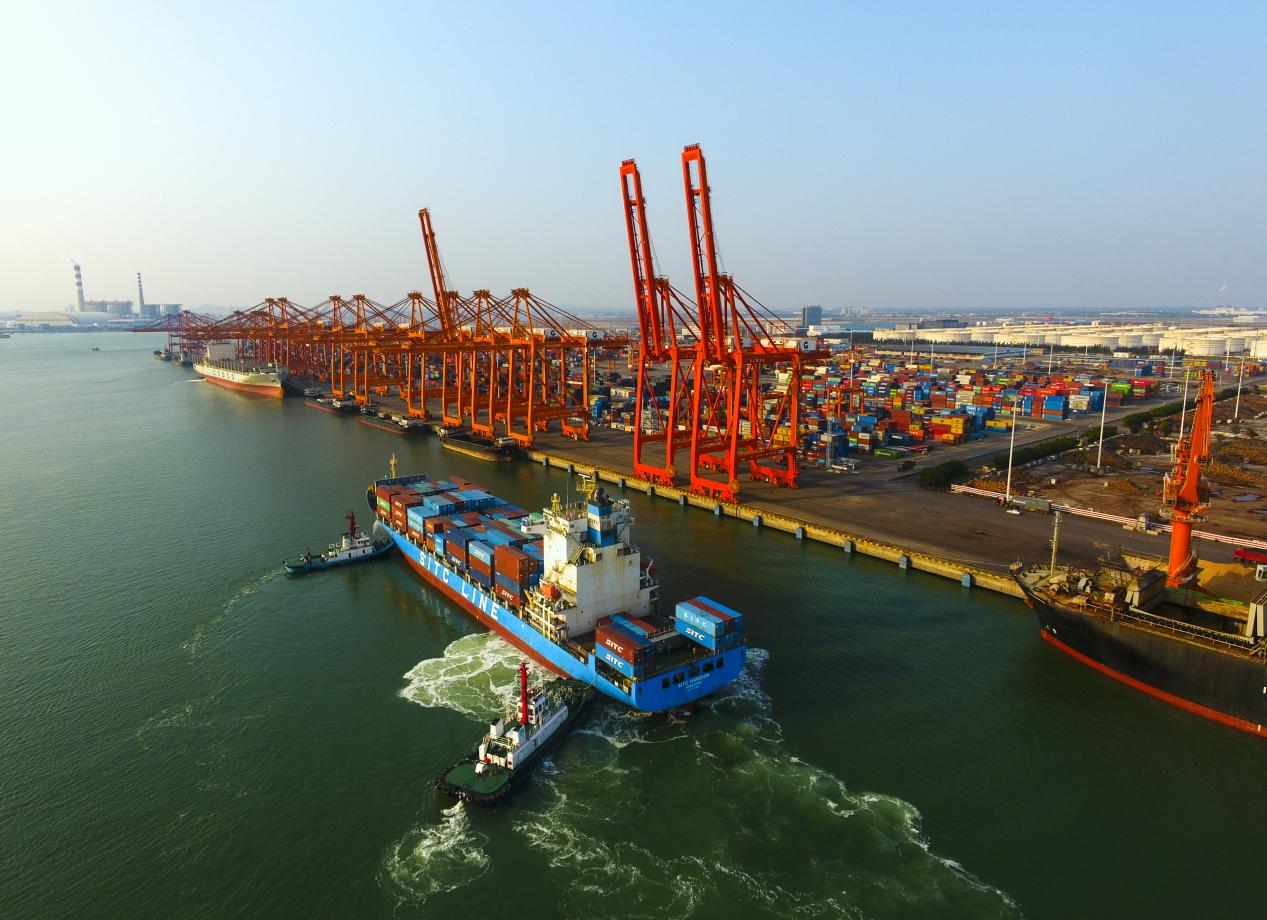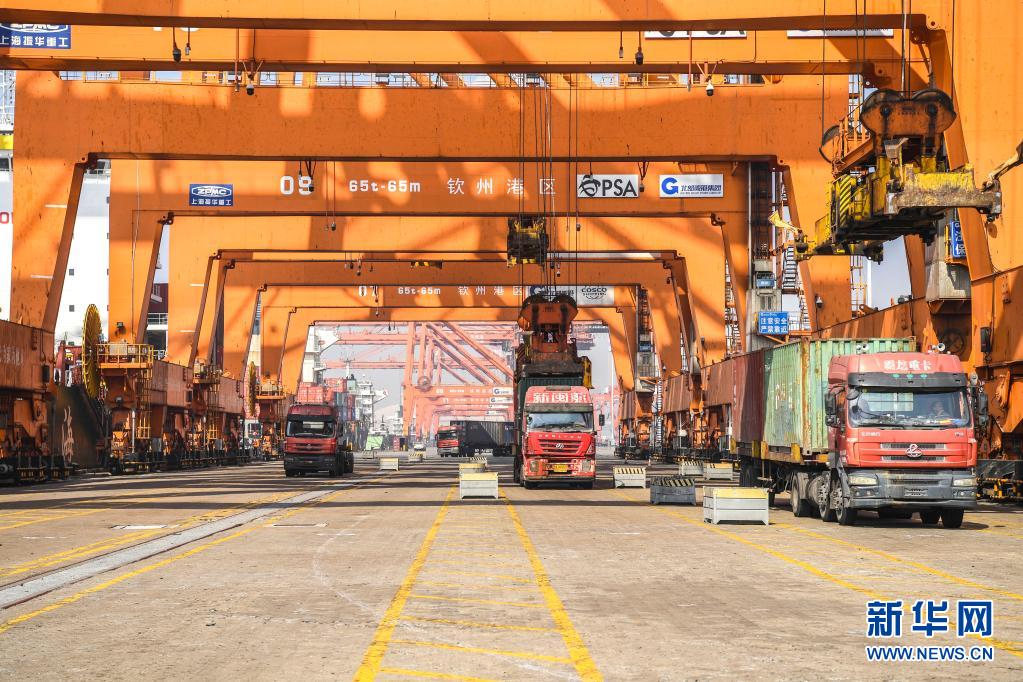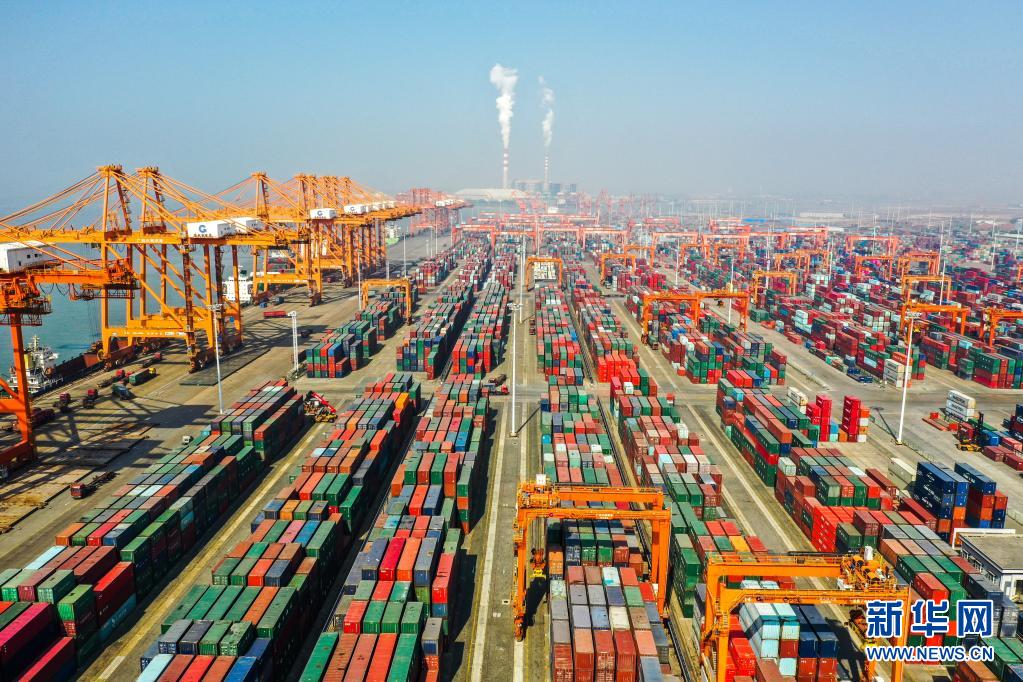

(Written by Huang Lixia / Translated by Chen Zhiying)
Along the Beibu Gulf, a forest of containers stand erectly, giant ships shuttle back and forth, and workers are busy in the wharf and in the park. The Beibu Gulf linking eleven countries provides strong impetus for Guangxi’s opening-up and development. It is the most convenient estuary in Southwest China, along which are three ports of Beihai, Qinzhou and Fangchenggang. It is Guangxi Beibu Gulf International Port Group Co., Ltd. (hereinafter referred to as Beibu Gulf Port Group), one of China’s top 500 enterprises, that runs this great business.
Integrating three ports to build a new hub
In 1984, Fangcheng Port firstly welcomed a 10000 ton cargo ship in its port and was listed as one of the 19 hub ports in China in 1989. At the same time, Beihai was listed as one of the 14 open costal cities in China in 1984, and the first 10000 ton berth of Beihai Port was completed and put into operation in 1986. On August 1, 1992, the Qinzhou Port started construction, where two 10000 ton berths were successfully completed 14 months later. Ever since, Qinzhou Port gradually developed into a major port in the region.
To adapt to the new situation of opening-up and development, in February 2007, Guangxi integrated Fangcheng Port, Qinzhou Port and Beihai Port into Guangxi Beibu Gulf Port, Beibu Gulf Port Group thus established. This has created a model in integrating ports across administrative regions.
As early as the beginning of its establishment, Beibu Gulf Port Group repositioned the functions and business scopes of the port, continuously innovated the port’s mechanism and system, promoted port integration, which improved the port’s comprehensive strength and competitiveness. Unified dispatching of the three ports and information sharing between inspection departments and the port have effectively improved the efficiency and avoided the homogenization and vicious competition among the three ports. The unloading efficiency of bulk cargo and container therefore has been improved by more than 30% compared with that before integration. Beibu Gulf Port Group has severed as the main force and played a leading role in building the New Western Land-Sea Trade Corridor, Beibu Gulf International Hub Port, Xijiang River Golden Waterway, and the Belt and Road within Guangxi.

Now, Beibu Gulf Port has 272 productive berths with a handling capacity of 280 million tons, among which 95 berths are above 10,000 tons, and the maximum berthing capacity of the port is 300,000 tons. It is navigable with more than 200 ports in more than 100 countries and regions in the world, forming a major maritime channel from the inland hinterland to Southeast Asia, the Indian Ocean, the Pacific Ocean, the Mediterranean and other places.
Serving as the main force in building the New Western Land-Sea Corridor
In April 2017, when China’s president Xi Jinping visited Beihai Tieshan Port District, he proposed that the Beibu Gulf Port should be well constructed, managed and operated with “first-class facilities, technology, management and services”, so as to contribute more to Guangxi, the Belt and Road, and the opening-up and cooperation.
In recent years, Beibu Gulf Port Group has constructed the New Western Land-Sea Trade Corridor under the standard of “four first-class”, built the most cost-effective logistics line connecting Western China and the world, and driven the industrial agglomeration along the corridor and improved the investment attraction of local governments.
From “connection” to “unimpededness”, the New Western Land-Sea Trade Corridor has opened three routes from Beibu Gulf Port to Chongqing, Hong Kong and Singapore, successively expanded 8 regular train routes connecting Chengdu, Lanzhou, Kunming and Guiyang, and linked Chongqing, Chengdu and Kunming with China’s Hong Kong and Singapore through Beibu Gulf Port, providing customers with high-quality and efficient logistics lines.

At present, 54 routes for container transporting and 61 sea-rail intermodal railway stations were put into operation under the New Western Land-Sea Trade Corridor, which connects 14 provinces, regions and cities in China and coves more than 300 ports in more than 100 countries and regions such as Singapore and Germany.
In the first half of 2021, 2,705 train were set off and 269,000 TEUs were transported under the New Western Land-Sea Trade Corridor, with a year-on-year increase of 112% and 319%.
Diversified extension of industrial chain
After its establishment, Beibu Gulf Port Group implemented the great port strategy. Taking the “three-port integration” as the main line and upholding the principle of “port-industry-trade” interaction, Beibu Gulf Port Group has built a comprehensive logistics system to make itself a comprehensive logistics supplier for the whole process, and implemented the “going out” strategy such as investing in ports, industries and parks in ASEAN countries, gradually becoming a multinational group with coordinated development of “port-industry-trade”.
Relying on the New Western Land-Sea Trade Corridor, Beibu Gulf Port Group has set its sights on the broader overseas market. Under the background of building the Belt and Road, Beibu Gulf Port Group actively participated in the investment and construction of the “Two Countries, Twin Parks” between China and Malaysia. In 2014, it acquired 40% equity from Malaysia’s Kuantan Port and took the lead in its upgrading work. In June 2015, Beibu Gulf Port Group and Beibu Gulf Port Co., Ltd. signed an agreement with Singapore’s PSA International and Pacific International Lines to jointly operate the project of No.3-6 Berths in Dalanping, Qinzhou Port. Today, Beibu Gulf Port Group is expanding its investment in Malaysia’s Kuantan Port and Brunei’s Muara Port, and promoting negotiations on the cooperative development and construction of ports with other ASEAN countries. Until now, the China-ASEAN Port Cities Cooperation Network already has 39 members.
In terms of trade, Beibu Gulf Port Group focuses on the development of nickel, chromium, tin, coal, soybeans, rapeseed, etc., and establishes procurement channels in dozens of countries of origin with bulk raw materials such as the United States, Brazil, India, Oman, the Philippines, and South Africa. The group strives to promote the internationalization of the trade of nickel and chromium, take the lead in coal trade in Southwest China and Southeast Asian countries, and have great influence in the trade of tin across China.
In addition, Beibu Gulf Port Group comprehensively utilizes the hydraulic resources of Xijiang River, to cultivate the modern clean energy industry integrating production, purchase, sale and supply along the river and near the port. Through introducing port industries such as stainless steel, grain and oil in the means of joint venture and cooperation, and merging and acquiring non-ferrous metal enterprises, Beibu Gulf Port Group cultivates the source of good and expands a new path of diversified development.
The standard of “four first-class” has become the development goal of Beibu Gulf Port Group, which will be conducive to promote its high-quality development. With the port as its core, Beibu Gulf Port Group has formed the industrial chain featuring “port-industry-trade” and the spatial layout featuring “port-industry-park”. All together forms the business layout integrating port, logistics, industry and trade, construction and development, energy, finance, investment and ship lock.
Accelerating the construction of Beibu Gulf International Gateway Port
Since Beibu Gulf Port Group was founded in 2007, the development speed has attracted much attention in the past ten years. According to relevant data, in the first three months of 2021, the cargo throughput of Beibu Gulf Port reached 61.9156 million tons, a year-on-year increase of 16.06%, of which the container throughput increased by 36.81% year-on-year, a “good start” in the first quarter of the opening year of the 14th Five-Year Plan.

In the ranking of national port cargo throughput and container throughput in January 2021, Beibu Gulf Port ranked top ten twice for the first time: The ranking of cargo throughput jumped from the 15th in 2020 to the 10th and the ranking of container throughput from 11th in 2020 to 9th.
In 2020, the cargo throughput of Beibu Gulf Port was 296 million tons, an increase of 16%. The container throughput increased from 1.42 million TEUs in 2015 to 5.05 million TEUs in 2020, an increase of 39%, ranking first among the major coastal ports in China. Beibu Gulf Port Group has become an important force in the opening-up and development of Guangxi Beibu Gulf Economic Zone. It has been shortlisted as one of the top 500 Chinese enterprises for nine consecutive years since 2012 and ranked 284 in 2020. It has also gained AAA credit rating and Moody’s baa3 credit rating.
2021 is the first year of the 14th Five-Year Plan. Beibu Gulf Port Group will resolutely implement the decisions and arrangements of the Party Committee and government of Guangxi Zhuang Autonomous Region, accelerate the construction of major projects and ensure their progress. At present, No.9 and 10 berths in Qinzhou Dalanping Port Area is under construction. No. 408-410 berths in Fangchenggang and No. 4 and 5 berths in Shawei, Qinzhou have been finished.
According to the 14th Five-Year Plan for National Economic and Social Development of Guangxi Zhuang Autonomous Region and the Long-Range Objectives Through the Year 2035, Guangxi will accelerate the construction of Beibu Gulf International Gateway Port in accordance with the standard of “four first-class”, Guangxi will take domestic and international first-class ports as the standards, improve service and implement the three-year action plan for Beibu Gulf International Gateway Port, so as to build a connected and efficient new hub of international shipping logistics and a new gateway for the opening-up of the western region.
At the same time, the 14th Five-Year Plan also mentions the need to “accelerate digital development”. The construction of Beibu Gulf Port will continue to promote the usage of artificial intelligence algorithms and 5g technology to build itself into a smart port, integrate new technologies into port industry, and innovate and expand port and shipping finance, data services, etc. Beibu Gulf Port Group, which has embarked on the digital fast lane, will also welcome a new development pattern.
桂ICP备14000177号 Copyright@2006-2013 Guangxi China-ASEAN Panorama Magazine Agency Co., Ltd. All Rights Reserved